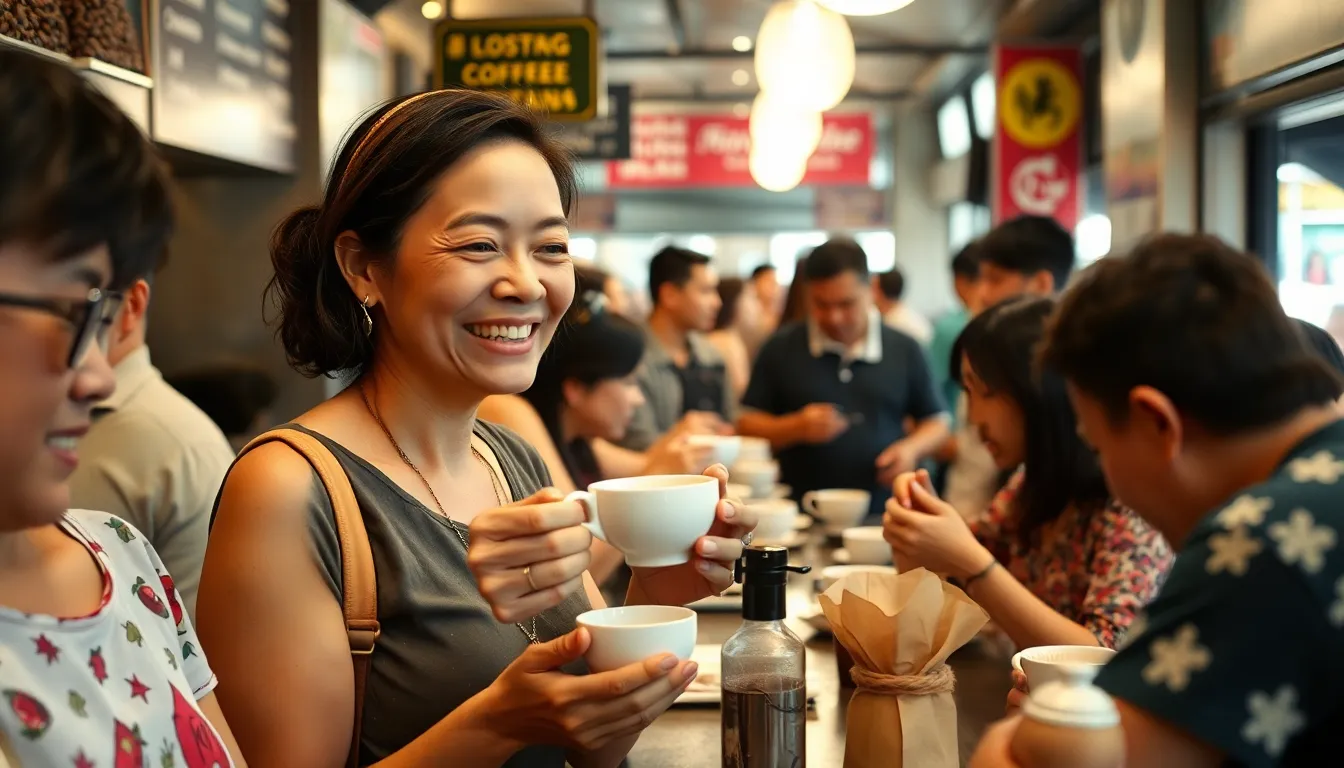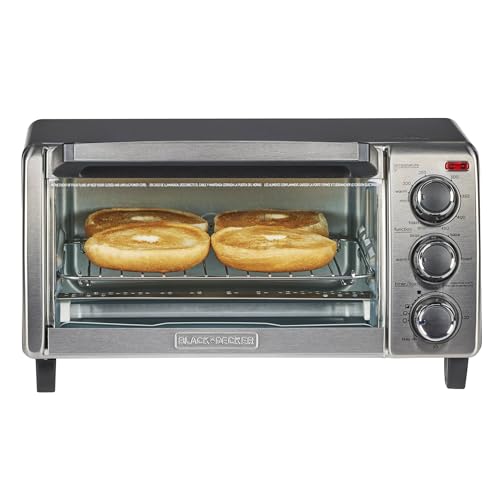Have you ever wondered what makes Singapore’s kopi coffee so uniquely irresistible? This traditional brew has been captivating locals and tourists alike for generations with its rich, robust flavor and distinctive preparation methods.
When you walk through Singapore’s vibrant hawker centers and kopitiams (traditional coffee shops), you’ll encounter the unmistakable aroma of freshly roasted coffee beans. Unlike Western-style coffee, kopi is typically brewed with butter-roasted Robusta beans and served with condensed milk, creating that signature sweet, creamy taste that’s become emblematic of Singaporean coffee culture. It’s a daily ritual deeply woven into the fabric of Singapore’s diverse culinary heritage.
What Makes Kopi Coffee Singapore’s Beloved Brew
Singapore’s kopi coffee stands apart from global coffee varieties through its unique preparation method and distinctive flavor profile. Kopi undergoes a special roasting process where Robusta beans are wok-fried with butter and sugar, creating a caramelized exterior that delivers a rich, robust taste. This traditional technique, passed down through generations, forms the foundation of Singapore’s coffee identity.
The secret to authentic kopi lies in its brewing apparatus – the sock filter. Coffee grounds are placed in this cotton filter, then hot water is poured through, extracting maximum flavor while capturing the grounds. This method produces a stronger, more concentrated brew compared to paper filters or French presses.
Kopi’s creamy texture comes from the addition of condensed milk rather than fresh milk or cream. The thick, sweet condensed milk balances the coffee’s bitterness perfectly, creating that signature taste locals crave daily. You’ll find regulars at kopitiams who can’t start their day without this sweet, creamy concoction.
The cultural significance of kopi extends beyond its taste – it’s woven into Singapore’s social fabric. Kopitiams serve as community gathering spots where people connect over steaming cups of kopi. Business deals, family celebrations, and everyday conversations all happen in these humble coffee shops, making kopi central to Singaporean social life.
“I’ve been coming to this same kopitiam for thirty years,” shares Mr. Tan, a retired teacher Rikki Manny interviewed. “The kopi tastes exactly the same as it did when I first visited – that consistency is what brings us back day after day.”
Kopi’s affordability makes it accessible to everyone, regardless of socioeconomic status. At just $1-2 SGD per cup, it’s significantly cheaper than international coffee chains while delivering a unique flavor experience that’s authentically Singaporean.
The Rich History of Kopi in Singapore

Kopi coffee emerged in Singapore during the late 18th century, born from a unique fusion of European coffee traditions and local Malay tastes. The beverage developed as immigrants from various cultures arrived in Singapore, creating a distinct coffee style that would become emblematic of the nation’s culinary identity.
From Colonial Roots to Cultural Icon
Singapore’s kopi story is deeply intertwined with the nation’s colonial past. Chinese domestic workers who left their employer households pioneered the early coffee scene, opening cafes that served the working class population. These entrepreneurs transformed low-quality Robusta beans into something remarkable by roasting them in woks with butter or lard and caramelizing them with sugar to mask bitterness. This innovative technique produced a rich, buttery coffee that quickly captured local palates.
The Hainanese immigrant community played an especially important role in establishing kopi culture. Arriving in the late 19th century and facing economic barriers, they carved out a niche in the service sector and began opening kopitiams (coffee shops) from the 1920s onward. Their community-based support systems enabled the rapid spread of these establishments, with over 200 kopitiams registered in Singapore by the 1920s.
Kopi’s popularity expanded through various iterations reflecting Singapore’s diverse tastes, including Kopi-O (black coffee with sugar) and Kopi-C (coffee with evaporated milk and sugar). Kopitiams evolved beyond mere coffee vendors to become vital social hubs where Singaporeans from all walks of life gathered, cementing kopi’s status as a cultural touchstone rather than just a beverage.
Traditional Preparation Methods
Traditional kopi preparation distinguishes itself from Western coffee methods through several key techniques. Robusta beans form the foundation of authentic kopi, chosen specifically for their suitability to Southeast Asia’s climate. These beans undergo a distinctive roasting process over charcoal with butter or lard and caramelized sugar, creating a depth of flavor unmatched by conventional coffee.
The brewing method employs a cloth “sock” filter, allowing water to steep gently through the coffee grounds. This technique preserves the full-bodied nature of the coffee while ensuring a remarkably smooth mouthfeel. The resulting brew carries richer flavors than those produced by drip or espresso methods common in Western coffee preparation.
Condensed or evaporated milk and sugar complete the classic kopi experience, creating that signature sweet, creamy profile beloved throughout Singapore. The traditional preparation methods have remained largely unchanged for generations, with many establishments still employing these time-honored techniques to maintain authenticity and connection to Singapore’s coffee heritage.
Top Kopi Coffee Shops in Singapore
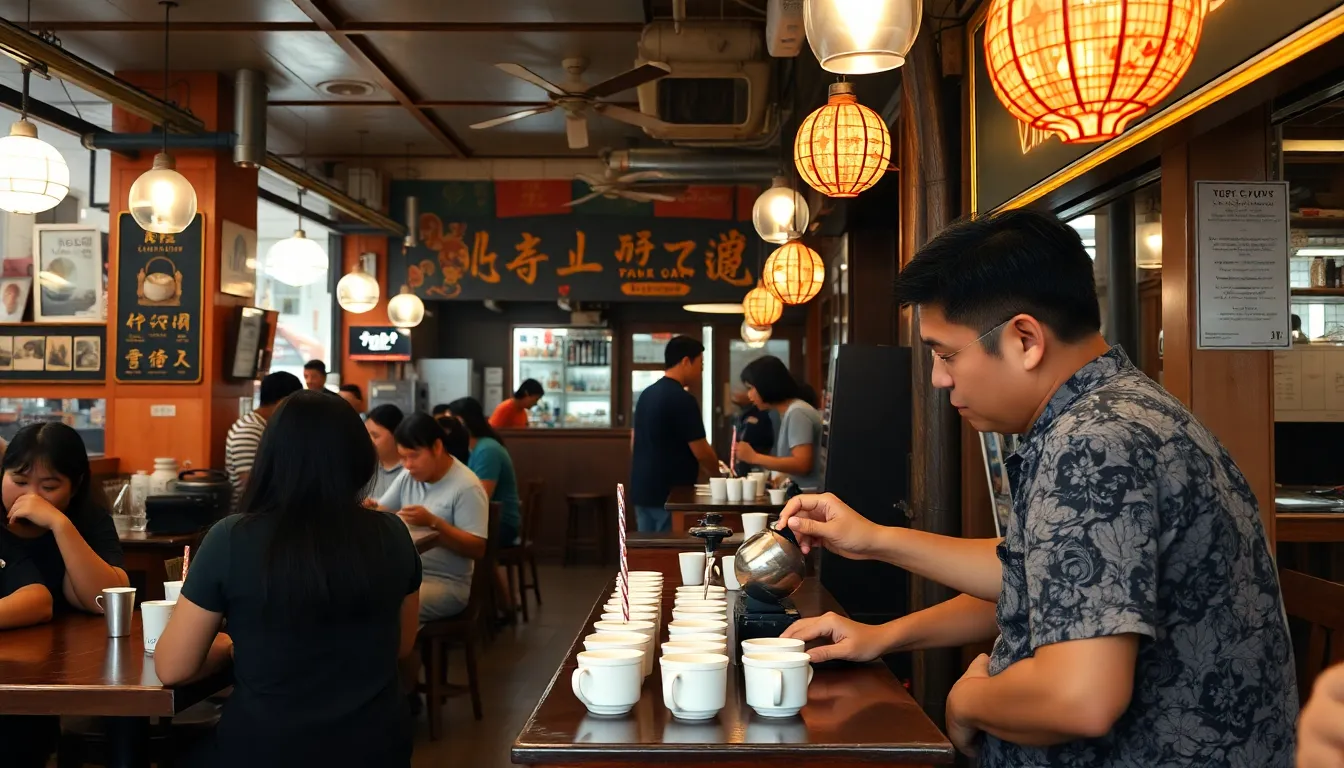
Singapore’s kopi culture beautifully blends rich heritage with modern interpretations, offering coffee enthusiasts diverse experiences across the island. From traditional kopitiams serving butter-roasted Robusta beans to contemporary cafés putting their spin on local coffee traditions, these establishments showcase the evolution of Singapore’s beloved kopi.
Heritage Coffee Houses
Traditional kopi shops in Singapore maintain time-honored preparation methods, roasting Robusta beans with butter and sugar for that distinctive caramelized flavor. Ya Kun Kaya Toast stands as an iconic heritage establishment, pairing classic kopi with their famous kaya toast and soft-boiled eggs for the quintessential Singaporean breakfast experience. The perfect balance of strong coffee and sweetened condensed milk creates that creamy texture locals have cherished for generations. Heap Seng Leong offers another authentic kopi experience, providing a laid-back atmosphere where you can watch the industry go by while savoring coffee prepared using decades-old recipes. Many Michelin-recommended traditional stalls continue to serve kopi using sock filters, extracting maximum flavor just as they’ve done for over half a century.
Modern Kopi Establishments
Contemporary coffee shops have embraced Singapore’s kopi heritage while introducing specialty coffee techniques and aesthetics. Kurasu near Bugis brings Japanese coffee sensibilities to Singapore, roasting their own beans and operating daily from 10 AM to 6 PM with a menu featuring both traditional and specialty preparations. Apartment Coffee focuses exclusively on specialty brews without food distractions, though its popularity often leads to weekend crowds. Coffee enthusiasts visiting Little India can stop by Asylum Coffeehouse, a compact café serving excellent specialty coffee alongside fresh pastries from 8:30 AM to 4:30 PM daily. Maxi Coffee Bar in Ann Siang Hill combines artisanal coffee with delectable sandwiches and pastries, making it perfect for a morning caffeine fix or leisurely brunch between Tuesday and Sunday. These modern establishments honor kopi traditions while introducing new brewing methods and bean selections that appeal to evolving tastes.
Understanding Kopi Varieties
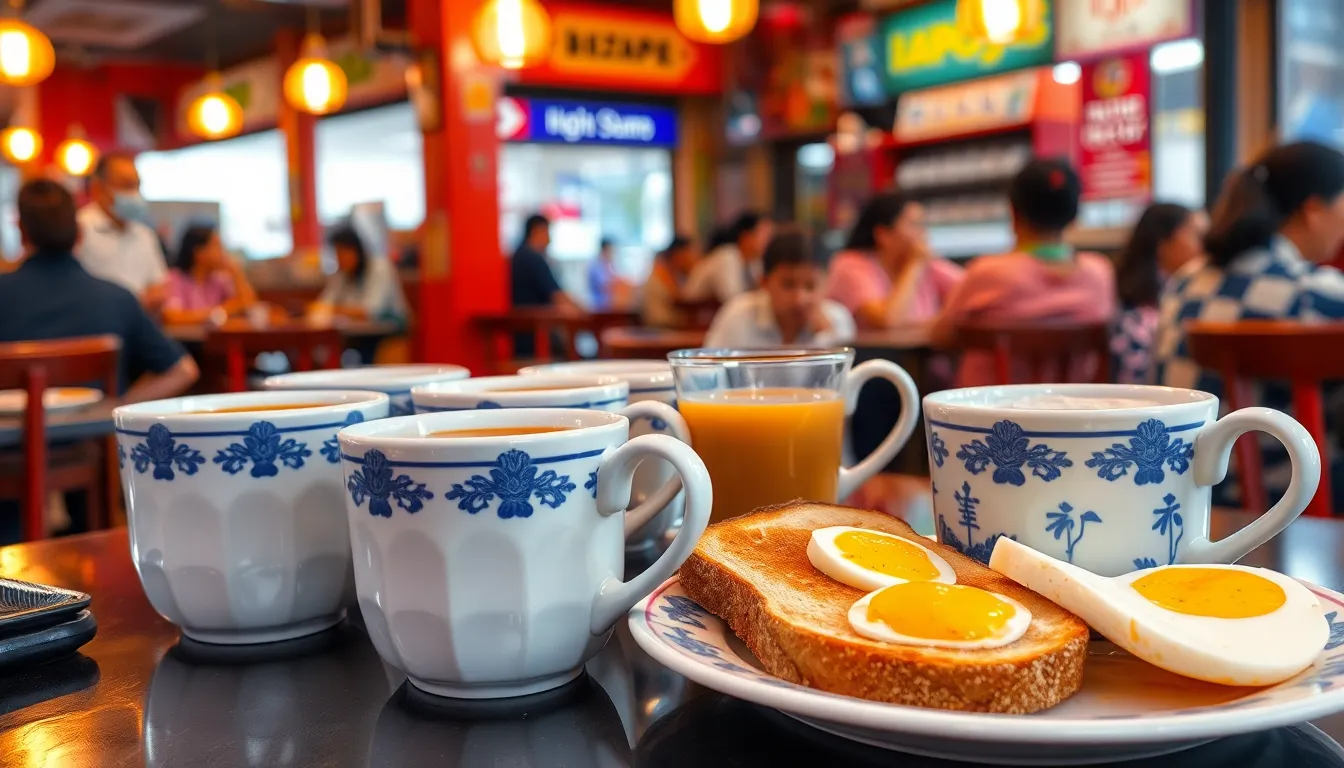
Singaporean kopi presents a rich tapestry of variations to suit every palate. Each variety offers distinct flavor profiles, sweetness levels, and calorie counts that reflect the diverse preferences of local coffee drinkers.
Kopi O, Kopi C, and Other Essential Orders
Traditional kopi serves as the foundation of Singapore’s coffee culture, featuring robusta beans roasted with sugar and margarine, then brewed through a sock-strainer. This default option comes with condensed milk, creating a strong, sweet beverage containing approximately 113 calories per cup. Kopi O offers a less creamy alternative with only sugar added (no milk), reducing the calorie count to about 66 calories while maintaining sweetness. For those monitoring calorie intake closely, Kopi O Kosong provides the purest coffee experience with neither sugar nor milk, containing just 5 calories.
Kopi C substitutes evaporated milk for condensed milk, resulting in a slightly less sweet profile with around 87 calories. Its sugar-free counterpart, Kopi C Kosong, contains only 47 calories while preserving the creamy texture from evaporated milk. Coffee enthusiasts seeking a more intense flavor gravitate toward Kopi Gao, brewed stronger with extra coffee grounds for a thicker consistency. Kopi Siew Dai caters to those preferring moderate sweetness with reduced sugar content. During Singapore’s hot weather, many locals refresh themselves with Kopi Peng, the iced version typically served with condensed milk and sugar.
Local Additions and Variations
Singapore’s kopi distinguishes itself through unique roasting techniques where beans undergo wok-roasting with sugar, margarine, and occasionally pineapple skin or maize. This process creates a distinctively dark, aromatic blend that forms the backbone of the kopi experience. The traditional brewing method employs a cotton sock-like strainer that extracts the coffee’s full-bodied flavor.
Authentic kopi typically arrives in thick white ceramic cups, sometimes adorned with blue-and-white patterns that reflect Singapore’s heritage. Glass cups have gained popularity in many hawker centers, offering a modern alternative to traditional servings. Takeaway options typically come in plastic or polystyrene cups or bags for convenience, though these packaging choices have raised environmental and health concerns among some consumers.
The complete kopi experience often includes a traditional Singaporean breakfast featuring kaya (coconut egg jam) and butter spread on charcoal-grilled toast, accompanied by soft-boiled eggs. This combination reflects Singapore’s multicultural influences, particularly from Hainanese and Peranakan traditions, creating a breakfast ritual that’s beloved across the island.
Over 70% of Singapore’s coffee consumption consists of kopi varieties, though health-conscious trends have influenced consumption patterns. Government initiatives addressing diabetes concerns have led many coffee shops to offer sugar-free options or serve sugar separately, allowing customers to control their intake. These adjustments have successfully reduced sugar consumption while preserving the authentic kopi experience that remains central to Singapore’s cultural identity.
Kopi Culture and Social Significance
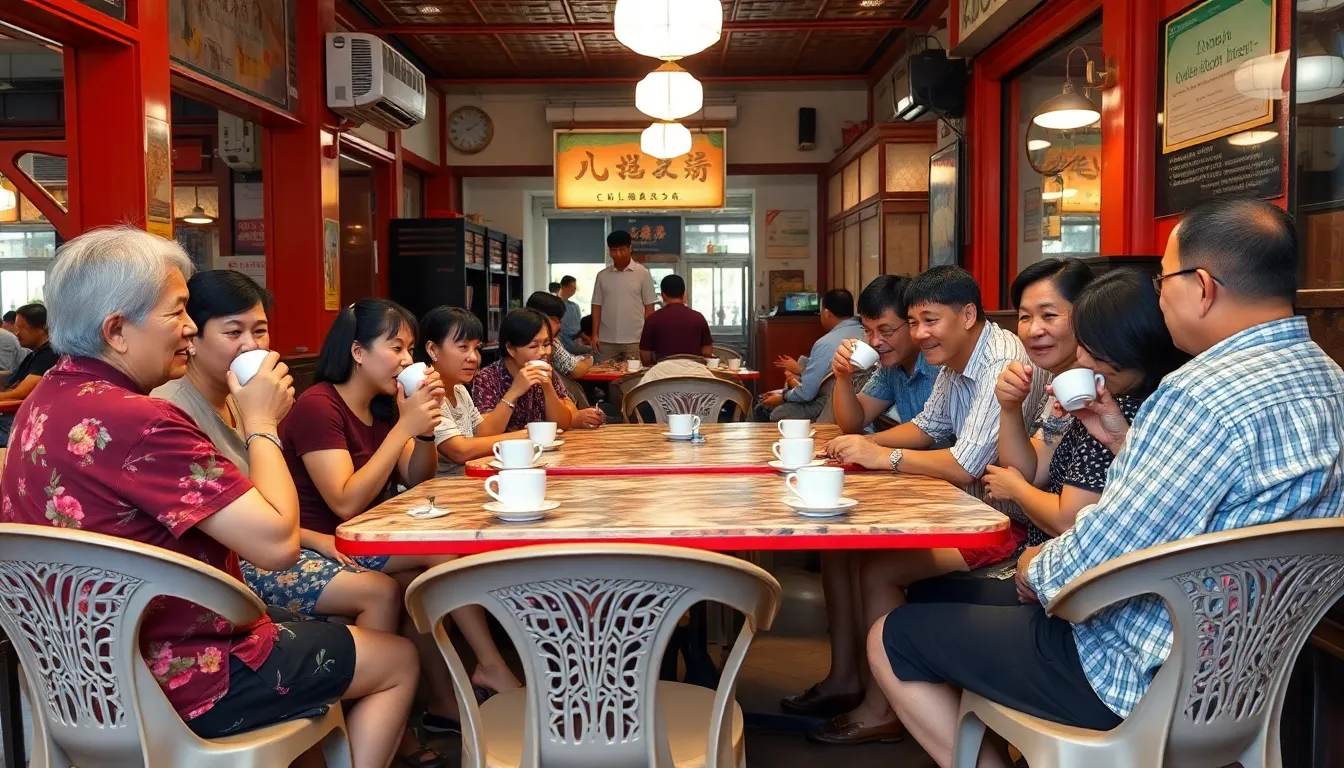
Kopi in Singapore represents far more than just a beverage—it’s a cultural institution deeply woven into the fabric of daily life. The distinct Singaporean coffee tradition emerged from the unique interplay of colonial influence, immigrant ingenuity, and local preferences, creating a coffee culture unlike any other in the industry.
The Kopitiam Experience
A kopitiam embodies the heart and soul of Singapore’s coffee culture, combining the Malay word “kopi” (coffee) with the Hokkien term “tiam” (shop). These traditional coffee shops serve as democratic social spaces where people across all ethnicities and social classes gather to share moments of their day. The distinctive brewing method uses a cloth “sock” filter that creates a remarkably smooth mouthfeel, improving the rich flavor profile of the strong Robusta beans. Walking into a kopitiam, you’re immediately transported to a simpler time—plastic chairs, marble-topped tables, and the rhythmic sound of cups being filled create an atmosphere of unpretentious comfort. Patrons engage in animated conversations, play traditional board games, or simply relax after long work hours in these no-frills environments that prioritize community over aesthetics.
How Kopi Connects Communities
Kopi functions as a powerful social equalizer in Singapore’s multicultural industry. The kopitiam tradition dates back to the 1920s-1950s when Hainanese immigrants, who arrived later than other Chinese groups, carved out an economic niche in the service sector by establishing these coffee shops. Their innovative techniques—roasting Robusta beans with sugar and butter—created the signature strong, sweet coffee that became a cultural touchstone. These spaces transcend Singapore’s diverse cultural boundaries, providing common ground where people from all walks of life can connect. Morning rituals at local kopitiams bring neighbors together over steaming cups of kopi and kaya toast, fostering relationships that strengthen community bonds. Business deals, family celebrations, and casual meetups all unfold in these humble settings, demonstrating how a simple cup of coffee serves as the backdrop for meaningful human connection across Singapore’s varied social industry.
Modern Trends in Singapore’s Kopi Scene
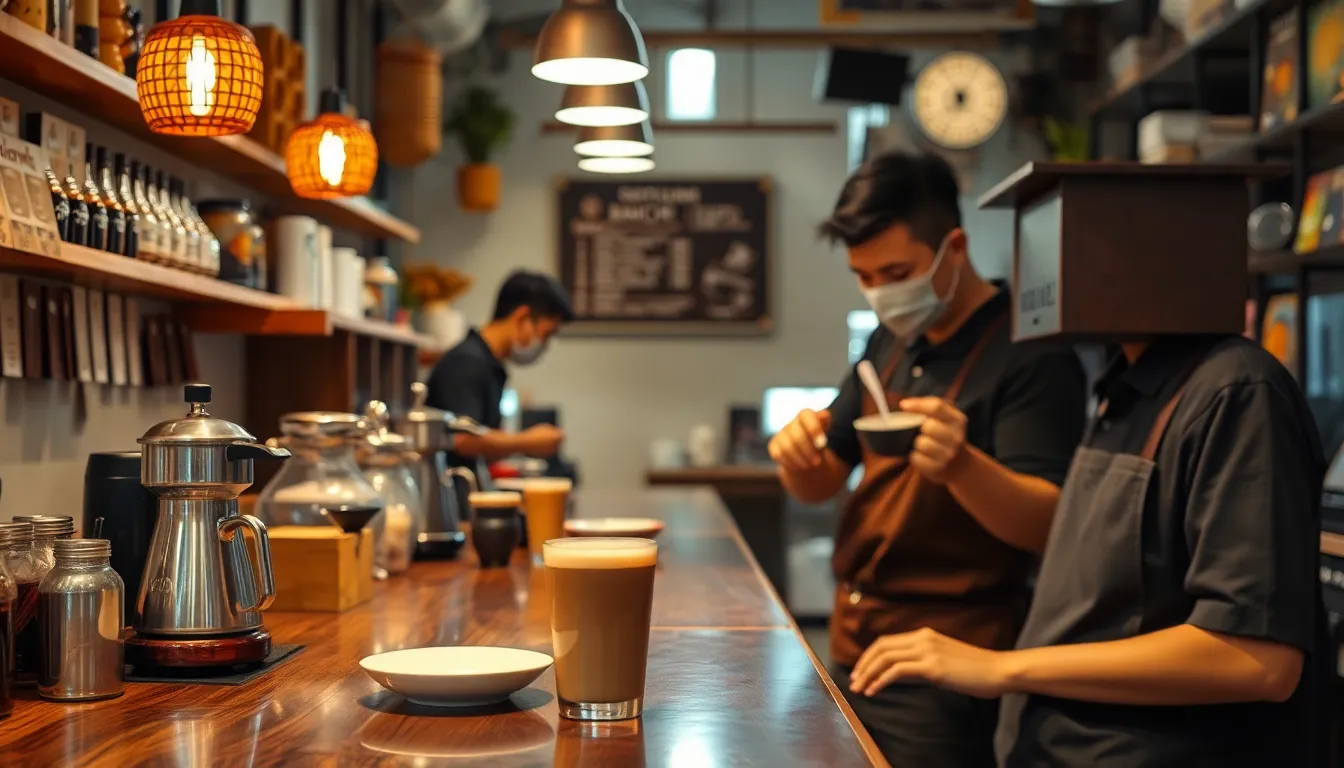
Singapore’s coffee industry is experiencing a remarkable evolution as traditional kopitiams now coexist with artisanal coffee houses. This ever-changing shift has created a vibrant scene where heritage brewing methods meet contemporary coffee innovations, satisfying both traditionalists and modern coffee enthusiasts.
Artisanal Takes on Traditional Kopi
Artisanal roasters like Kim Guan Guan Coffee Trading stand at the forefront of preserving traditional kopi craftsmanship while introducing refined techniques. These dedicated artisans maintain classic roasting methods that have defined Singaporean coffee for generations, carefully sourcing quality Robusta beans from Indonesia and Vietnam. Their commitment extends beyond preservation as they subtly innovate to accommodate changing consumer preferences without sacrificing authenticity. By balancing time-honored practices with thoughtful adaptations, these roasters ensure that traditional kopi remains relevant in Singapore’s evolving coffee culture. The nuanced approach has attracted younger coffee drinkers who appreciate both heritage and quality, creating new audiences for this cultural staple.
Fusion Innovations
The fusion movement in Singapore’s kopi scene represents a creative reimagining of this beloved beverage. Specialty cafés throughout the city experiment with incorporating traditional kopi elements into contemporary offerings, creating unique hybrid drinks that bridge cultural divides. These innovative creations include kopi-infused cocktails, desserts that feature the distinctive butter-roasted coffee flavor, and specialty beverages that combine traditional brewing methods with international coffee trends. The experimentation extends to presentation styles, with some establishments serving traditional kopi in modern glassware or incorporating latte art techniques into local coffee preparations. This cross-cultural approach appeals particularly to younger Singaporeans and tourists seeking authentic experiences with modern twists. The result is a ever-changing coffee culture that honors its roots while embracing global influences, securing kopi’s place in Singapore’s culinary future.
Conclusion
Kopi coffee represents the heart and soul of Singapore’s vibrant coffee culture. You’ll find this unique brew offers an authentic taste experience that’s distinctly different from Western coffee varieties thanks to its butter-roasted Robusta beans and creamy condensed milk.
Whether you’re sipping a traditional cup at a historic kopitiam or enjoying modern interpretations at specialty cafés you’re participating in a cherished social ritual that transcends generations. The affordability and accessibility of kopi have cemented its place in daily Singaporean life.
As Singapore’s coffee scene continues to evolve kopi remains the bridge between heritage and innovation. Don’t miss the opportunity to immerse yourself in this rich cultural tradition during your visit to Singapore.
Frequently Asked Questions
What makes Singapore’s kopi coffee unique?
Singapore’s kopi stands out due to its distinctive butter-roasted Robusta beans, which are wok-fried with sugar to create a caramelized exterior. This traditional roasting method, combined with the sock filter brewing technique and the addition of condensed milk, results in a sweet, creamy, and robust flavor profile unlike any Western coffee. The preparation process has remained largely unchanged for generations.
How is kopi traditionally prepared?
Kopi is prepared by wok-frying Robusta beans with butter and sugar until caramelized. The roasted beans are ground and brewed using a sock filter (a cloth strainer) that extracts maximum flavor. The strong coffee is then typically mixed with condensed milk, creating its signature sweet and creamy taste. The entire process is usually performed by experienced “kopi uncles” who have perfected their technique over decades.
What are the different varieties of kopi available in Singapore?
Singapore offers several kopi variations to suit different preferences. Kopi (standard) contains condensed milk, Kopi-O is black coffee with sugar, Kopi-C uses evaporated milk instead of condensed milk, Kopi Gao is extra strong, and Kopi Peng is iced coffee. Each variation can be customized with “siu dai” (less sweet) or “kosong” (no sugar) options to accommodate health-conscious customers.
How much does a cup of kopi cost in Singapore?
A cup of traditional kopi in Singapore is remarkably affordable, typically priced between $1-2 SGD (approximately $0.75-1.50 USD). This accessibility has contributed to kopi’s popularity across all social classes and made it a daily staple for many Singaporeans. Even at modern kopitiam chains or specialty cafés that serve artisanal versions, prices remain reasonable compared to international coffee chains.
What is the cultural significance of kopi in Singapore?
Kopi is more than a beverage—it’s a cultural institution in Singapore that fosters community connections. Kopitiams (traditional coffee shops) serve as democratic social spaces where people from all backgrounds gather for conversations, business meetings, and celebrations. Dating back to the 1920s-1950s when Hainanese immigrants established these coffee shops, the kopi tradition has become a unifying force in Singapore’s multicultural society.
What are some must-visit kopi shops in Singapore?
Top traditional kopitiams include Ya Kun Kaya Toast, known for its kopi and kaya toast combination, and Heap Seng Leong, which offers the nostalgic kopi with butter. For modern interpretations, visit Kurasu or Apartment Coffee, which blend specialty coffee techniques with kopi traditions. Killiney Kopitiam, Singapore’s oldest kopitiam chain, and Tong Ah Eating House are also historical establishments worth experiencing.
How has kopi evolved in modern Singapore?
While traditional kopitiams remain popular, Singapore’s coffee scene has evolved to include artisanal roasters and specialty cafés that honor kopi traditions while introducing refinements. Establishments like Kim Guan Guan Coffee Trading preserve traditional craftsmanship while incorporating modern techniques. The fusion movement has created hybrid drinks that blend kopi elements with contemporary coffee trends, attracting younger generations to this cultural staple.
When did kopi first become popular in Singapore?
Kopi gained popularity in Singapore in the late 18th century when European coffee traditions merged with local Malay tastes. The beverage’s prominence grew through Chinese domestic workers and especially the Hainanese immigrant community, who opened kopitiams throughout the early 20th century. They ingeniously transformed low-quality Robusta beans (which were more affordable and available) into the beloved drink that became integral to Singapore’s culinary identity.

